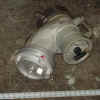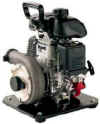
|
 |
 |
 |
| Piston
valve
The side intakes of a
pumper go directly into the pump. Many departments add an external valve
such as this to make connections easier.
|
Valves
5" butterfly valve,
and 5" to 2.5" gated wye.
|
Valves
Another view.
|
Adaptors
1.5" and 2.5"
double male adaptors, double female adaptors and a 2.5" to
1.5" reducer.
|
 |
 |
 |
 |
| Adaptors
5" to 2.5" wye,
2.5" to 5" Stortz increaser, 5" Stortz to 5"
threaded adaptor.
|
Manifold
This is a manifold or
portable hydrant. It has 5" Stortz connections on either end and
four 2.5" gated discharges.
|
Manifold
Another view. Manifolds
can be used to allow a pumper to supply water in a controlled fashion to
a remote point, basically creating an above ground water system.
|
Wye
5" to 2.5" wye
|
 |
 |
 |

|
| Wye
1.5" gated wye, and
1" gated wye.
|
Hose
jacket
This device can be used
to provide a temporary fix for a leaking hose.
|
Hose
clamp
Hose clamps can be used
to stop the flow of water in hose up to 3" in diameter.
|
Foam
eductor
This is a device used to
add foam into a hose line for pumpers that don't have a built in foam
system. Foam is used to fight flammable liquid fires.
|
 |
 |
 |
 |
| Nozzles
1.5" combination fog
nozzles.
|
Nozzles
1.5" and 1"
combination fog nozzles.
|
Nozzles
1.5" combination fog
nozzles, one with a pistol grip, one without.
|
Nozzles
2.5" combination fog
nozzles.
|
 |
 |
 |
 |
| Nozzles
2.5" combination
breakaway nozzle with a pistol grip. The combination fog tip can be
removed leaving a smoothbore tip. The small twin tip nozzle is a 1"
forestry nozzle, one side provides a short range fog spray, the other
side has a longer reach solid stream.
|
Nozzles
2.5" combination fog
nozzle on a play-pipe (dual handles), and a 1.5" combination fog
nozzle with a pistol grip.
|
Nozzle
2.5" smoothbore
nozzle with a play-pipe (handles).
|
Nozzle
2.5" combination fog
nozzle with a play-pipe (handles).
|

|

|
 |
 |
| Nozzles
1.5" smoothbore
nozzles, one with a pistol grip on without. These nozzles can be used
with a 1/2" tip or a 15/16" tip.
|
Nozzles
2.5" smoothbore
nozzles. These nozzles can be used with a 1/2" tip or a 1 1/8"
tip.
|
Nozzle
These are combination fog
nozzles with a clamp on foam agitator used when foam is applied. It has
a screen inside the tube which helps mix air into the foam and water
mixture.
|
Nozzle
This is an antique smooth
bore nozzle.
|
 |
 |
 |
|
| Nozzle
1" foam nozzle. This
nozzle has a screen inside the tube to agitate the foam and water
mixture.
|
Nozzles
Foam nozzle, and a
distributor or cellar nozzle. The silver nozzle is a cellar nozzle, the
light colored part spins around. This nozzle is generally inserted
through a hole near the fire when the fire area is inaccessible.
|
Wildland
Nozzles
Twin tip forester nozzle
and a mop up wand. The long wand can be attached to the forester nozzle
to allow better access into stump holes or up inside burned out trees.
The long blue device is another style of foam nozzle. Also a 1.5"
and 1" gated wye.
|
|

|

|
|
|
| Ejector,
gizmo and check valve The
ejector is similar in appearance to the foam eductor, but is is used to
supply water. It uses the venturi principle to add water to the water
pumped through the ejector. Almost 2 gallons are added for each gallon
passing through the ejector. It is most commonly used to refill an
engine when there is no suitable drafting spot available.
|
Ejector,
gizmo and check valve The
ejector is shown here with the one way valve and strainer removed. The
gizmo or inline shut off is the small silver device. It is used to
reduce water flow in a hose, this is helpful in long downhill hoselays
where pressure can quickly build up due to gravity. The check and
bleeder valve is used to reduce the back pressure on a pump when pumping
up steep hills.
|
|
|
 |
 |
 |
 |
| Portable
monitor
Portable monitors provide
are used to provide large volumes of water or to allow water to be
applied where it is too dangerous to leave a firefighter.
|
Portable
monitor
Another view. This is a
modern monitor, it is lighter in weight and more compact than older
monitors.
|
Portable
monitor
This is an older portable
monitor but these are still very common, they are often mounted on top
of an engine allowing them to be quickly used from the engine, or
removed and used at a remote location.
|
Portable
monitor
Another view of the same
monitor. Monitors typically have two or three 2.5" intakes for the
supply hoses.
|
 |

|
|
|
| Portable
monitor
Another style of portable
monitor. This one has a combination fog tip. Most monitors have
removable tips allowing fog or solid streams depending on the need.
|
Portable
tank
This is a folding
portable tank to create a water source where one doesn't exist. This
particular tank can hold 2500 gallons.
|
|
|
 |

|

|

|
|
Mark 3 Portable pump
Portable pumps are often
used in rural areas with poor water systems, they are particularly
common on wildland fires. The Mark 3 uses a fairly large 2 stroke engine
and is capable of providing more pressure than most portable pumps, a
useful feature in mountainous terrain.
|
Mark 3 Portable pump
This is a very common portable
pump used for wildland fires. It was first sold by Pacific Marine so it is
sometimes called a P-marine. The Mark 3 has been in use since the late
40's and is still very common today.
|
Mark 3 Portable pump
At 55 lbs it is one of
the heavier portable pumps found in common use. A padded pack frame is
available to make it easier to hike the pump into remote locations.
These pumps are often used in the wilderness by smokejumpers and
helitack crews
|
Mark 3 Portable pump
Here is the pump with its
fuel can, fuel line and a pump kit. The pump kit typically includes
tools, spare parts, a 1.5" suction hose and assorted hose
fittings.
|
 |

|

|

|
| Honda
pump
This is a small portable
pump powered by a Honda 4 stroke motor. It is much lighter than the Mark
3. The four stroke motor does not require special gas and is much
quieter than 2 stroke motors.
|
Honda
pump
Another view of the
Honda. While small pumps like this are not as powerful as a Mark 3 they
are approximately 1/3 the weight and much easier to operate.
|
Wickman
pump
This is another small
portable pump, but it uses a 2 stroke engine. It is similar in
performance to the Honda but is slightly smaller and lighter. It also
requires mixed fuel and is noisier.
|
Wickman
pump
Another view. Unlike the
Mark 3 most small portable pumps have a built in gas tank. A kit is
available to allow this pump to use a 5 gallon fuel can like the one
used with the Mark 3.
|

|

|

|

|
| Floating
pump
This is a floating
portable pump. It can be dropped into a static water source such as a
pond or swimming pool. This pump is also available with a smaller ground
mount instead of the floatation collar.
|
Floating
pump
This is a larger floating
pump. Most portable pumps have a 1.5" discharge, this pump has a
2.5" discharge.
|
Floating
pump
Another view.
|
Floating
pump
Another view.
|
 |

|

|

|
| Portable
pump
This is an older portable
pump. In addition to their use on fires pumps like this are also used to
pump out flooded buildings.
|
Portable
pump
Another view.
|
Homelite
Portable
pump
This is another older
pump. This is a larger pump made by Homelite. This pump has a 2.5"
discharge which is unusual on a portable pump.
|
Homelite
Portable
pump
Another view of the pump.
|

|

|

|
|
| Portable
pump
This is another small portable
pump.
|
Old
Portable pump
This is a portable pump
from the 1930's. It is powered by an Evenrude motor, a company better
known for its outboard boat motors.
|
Old
Portable pump
Another view. This type of pump
was used on a ground mount or mounted on a
brush truck.
|
|